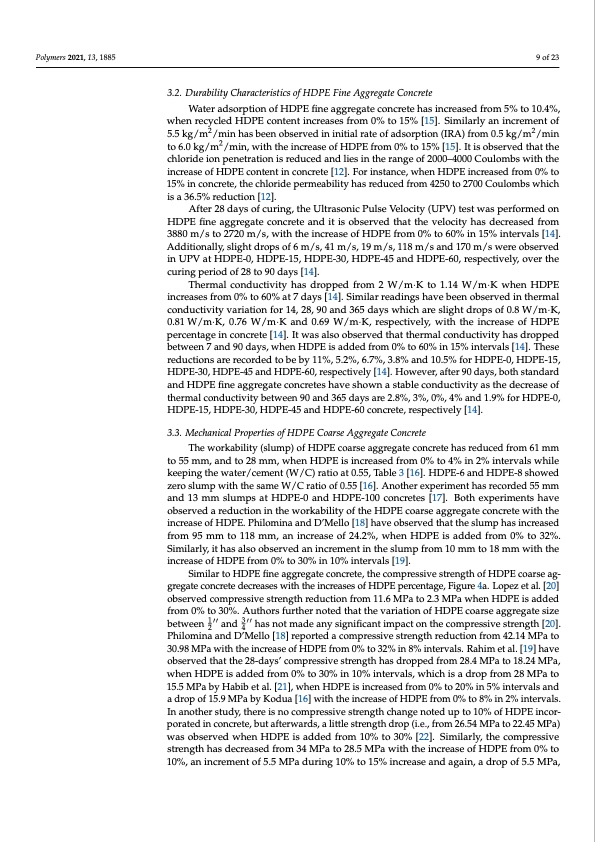
PDF Publication Title:
Text from PDF Page: 009
Polymers 2021, 13, 1885 9 of 23 3.2. Durability Characteristics of HDPE Fine Aggregate Concrete Water adsorption of HDPE fine aggregate concrete has increased from 5% to 10.4%, when recycled HDPE content increases from 0% to 15% [15]. Similarly an increment of 5.5 kg/m2/min has been observed in initial rate of adsorption (IRA) from 0.5 kg/m2/min to 6.0 kg/m2/min, with the increase of HDPE from 0% to 15% [15]. It is observed that the chloride ion penetration is reduced and lies in the range of 2000–4000 Coulombs with the increase of HDPE content in concrete [12]. For instance, when HDPE increased from 0% to 15% in concrete, the chloride permeability has reduced from 4250 to 2700 Coulombs which is a 36.5% reduction [12]. After 28 days of curing, the Ultrasonic Pulse Velocity (UPV) test was performed on HDPE fine aggregate concrete and it is observed that the velocity has decreased from 3880 m/s to 2720 m/s, with the increase of HDPE from 0% to 60% in 15% intervals [14]. Additionally, slight drops of 6 m/s, 41 m/s, 19 m/s, 118 m/s and 170 m/s were observed in UPV at HDPE-0, HDPE-15, HDPE-30, HDPE-45 and HDPE-60, respectively, over the curing period of 28 to 90 days [14]. Thermal conductivity has dropped from 2 W/m·K to 1.14 W/m·K when HDPE increases from 0% to 60% at 7 days [14]. Similar readings have been observed in thermal conductivity variation for 14, 28, 90 and 365 days which are slight drops of 0.8 W/m·K, 0.81 W/m·K, 0.76 W/m·K and 0.69 W/m·K, respectively, with the increase of HDPE percentage in concrete [14]. It was also observed that thermal conductivity has dropped between 7 and 90 days, when HDPE is added from 0% to 60% in 15% intervals [14]. These reductions are recorded to be by 11%, 5.2%, 6.7%, 3.8% and 10.5% for HDPE-0, HDPE-15, HDPE-30, HDPE-45 and HDPE-60, respectively [14]. However, after 90 days, both standard and HDPE fine aggregate concretes have shown a stable conductivity as the decrease of thermal conductivity between 90 and 365 days are 2.8%, 3%, 0%, 4% and 1.9% for HDPE-0, HDPE-15, HDPE-30, HDPE-45 and HDPE-60 concrete, respectively [14]. 3.3. Mechanical Properties of HDPE Coarse Aggregate Concrete The workability (slump) of HDPE coarse aggregate concrete has reduced from 61 mm to 55 mm, and to 28 mm, when HDPE is increased from 0% to 4% in 2% intervals while keeping the water/cement (W/C) ratio at 0.55, Table 3 [16]. HDPE-6 and HDPE-8 showed zero slump with the same W/C ratio of 0.55 [16]. Another experiment has recorded 55 mm and 13 mm slumps at HDPE-0 and HDPE-100 concretes [17]. Both experiments have observed a reduction in the workability of the HDPE coarse aggregate concrete with the increase of HDPE. Philomina and D’Mello [18] have observed that the slump has increased from 95 mm to 118 mm, an increase of 24.2%, when HDPE is added from 0% to 32%. Similarly, it has also observed an increment in the slump from 10 mm to 18 mm with the increase of HDPE from 0% to 30% in 10% intervals [19]. Similar to HDPE fine aggregate concrete, the compressive strength of HDPE coarse ag- gregate concrete decreases with the increases of HDPE percentage, Figure 4a. Lopez et al. [20] observed compressive strength reduction from 11.6 MPa to 2.3 MPa when HDPE is added from 0% to 30%. Authors further noted that the variation of HDPE coarse aggregate size between 1 ′ ′ and 3 ′ ′ has not made any significant impact on the compressive strength [20]. 24 Philomina and D’Mello [18] reported a compressive strength reduction from 42.14 MPa to 30.98 MPa with the increase of HDPE from 0% to 32% in 8% intervals. Rahim et al. [19] have observed that the 28-days’ compressive strength has dropped from 28.4 MPa to 18.24 MPa, when HDPE is added from 0% to 30% in 10% intervals, which is a drop from 28 MPa to 15.5 MPa by Habib et al. [21], when HDPE is increased from 0% to 20% in 5% intervals and a drop of 15.9 MPa by Kodua [16] with the increase of HDPE from 0% to 8% in 2% intervals. In another study, there is no compressive strength change noted up to 10% of HDPE incor- porated in concrete, but afterwards, a little strength drop (i.e., from 26.54 MPa to 22.45 MPa) was observed when HDPE is added from 10% to 30% [22]. Similarly, the compressive strength has decreased from 34 MPa to 28.5 MPa with the increase of HDPE from 0% to 10%, an increment of 5.5 MPa during 10% to 15% increase and again, a drop of 5.5 MPa,PDF Image | Concrete Incorporated with Recycled High-Density Polyethylene HDPE

PDF Search Title:
Concrete Incorporated with Recycled High-Density Polyethylene HDPEOriginal File Name Searched:
polymers-13-01885.pdfDIY PDF Search: Google It | Yahoo | Bing
Development of a solar powered Electric Ship The Electricship website originally started off as a project to develop a comprehensive renewable, affordable, modular electric ship... More Info
Modular Boat Hull Composite The case for a unsinkable, modular composite hybrid boat hull... More Info
MS Burgenstock Hybrid Electric Catamaran Lake Lucerne Unique shuttle servicing Lucerne to the Burgenstock Resort... More Info
Ground Power Unit GPU Powered by Lithium Ion Batteries The goal of the Ground Power Unit is to provide a readily accessible, modular, ready-to-power solution for remote power... More Info
| CONTACT TEL: 608-238-6001 Email: greg@electricship.com | RSS | AMP |